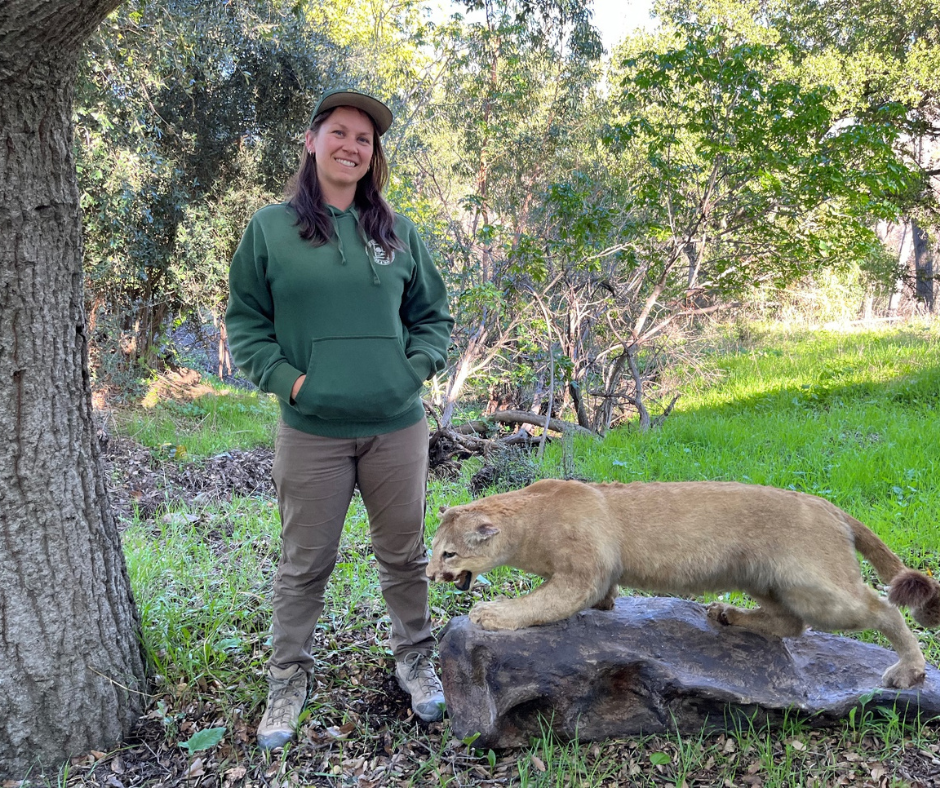Our Neighbors, the Mountain Lions by Ranger, Lauren Kaiser (May 2024)

The Rise in Mountain Lion Sightings
For those who have not heard, there has been a slight rise in sightings of an elusive wild creature around the area this winter. They have been spotted in Holdener Park, Sycamore Grove Park, and the neighborhoods around Independence Park. Yes, I am talking about the magnificent mountain lion. With the rise in sightings, there has also been an understandable rise in safety concerns. So, I figured this was a great opportunity to look deeper at our feline neighbors and best practices to ensure everyone is safe while sharing our outdoor spaces.
Fun Facts About Mountain Lions
Let us start with some fun basics. Their scientific Latin name, Puma concolor, can be translated to “same color.” When looking at their very uniform tawny coat, it makes a lot of sense. Few wild cats have no major markings, such as stripes or spots, anywhere on their coats. Even bobcats have distinctive markings and a mottled look to their coats to help them blend into the shadows of the tall grasses and shrubs where they tend to live. This makes the mountain lion a uniquely plain-looking cat from a distance.
Habitat and Population

However, to make up for their lack of markings, the mountain lion has an excessive number of common names given to them over the years. According to California Fish and Wildlife, this feline has approximately 40 different common names, including, but not limited to, puma, cougar, panther, painter, catamount, and screamer. As fun as it would be for me to try and use all 40 names throughout this article, for the sake of our editor and my sanity, I will continue with my go-to common name, Mountain Lion.
Like all cats, these felines are true carnivores, eating other wildlife such as deer, rabbits, and squirrels. Along with the other local predators, mountain lions help keep the herbivores from eating every green plant before it can reproduce, giving them the important role of balancing our ecosystems and keeping other populations healthy.
Identifying Mountain Lion Presence
While some (me included) may assume the mountain lion is the largest wild cat in North America, they are beaten out of that top spot by the few remaining wild jaguars along the U.S. and Mexico border. For comparison’s sake, mountain lions typically weigh about 100-170 lbs, while jaguars can weigh anywhere from 120 to 210 lbs. So, they may not be the largest cat in North America, but they rank as the fourth largest wild cat in the world, just behind their jaguar cousins.
These large felines can be found throughout the western hemisphere of North and South America. However, their population is dwindling due to several human factors, such as habitat loss and poaching. In California, mountain lions enjoy a solitary lifestyle in the hills and mountains. They do not enjoy hanging out with other mountain lions, and they especially do not like being around humans. However, the years of habitat loss have forced the mountain lions to get closer and closer to humans to locate their food sources, making humans increasingly fearful of their presence in our communities.
Also, their calls and vocalizations are the stuff of nightmares. If you have yet to listen to recordings of mountain lion chatter, I highly recommend taking a moment to do so. You will quickly understand how the legends of screaming women and other local mythology started.

I also recommend looking for videos from the Santa Cruz Puma Project. They have posted video footage from the research of local mountain lions reacting to different environmental noises, including human voices. The results are both humorous and eye-opening. The researchers looked for cached (stored) kills from mountain lions, set up wildlife cameras along with a small speaker nearby, and waited for the mountain lion to return to feast. Once the feline is comfortable, they play different noises through the speaker, starting with local nature sounds such as frogs and crickets and then playing a clip of human voices. Upon hearing the human voices, you will see the mountain lions immediately jump up and run away. These cats don’t want to deal with humans and will leave their hard-won food to avoid us!
One of the few ways we know if a mountain lion has been in the area is by finding paw prints. Their paws are very distinctive compared to the other large predators in the area. If you are new to tracking, it may be difficult to pick out a dog print from a cat print unless they are side by side.
Here are a few differences to look for:
- If they leave toenail markings, it’s probably a dog; cats rarely walk with their claws extended.
- The bottom of the center pad makes a unique “M” shape.
- Draw an “x” through the center of the print. If the “X” passes between the toes and does not touch the center pad, it’s a dog; if it does touch the center pad, it’s a cat.
- Lastly, mountain lions will be bigger overall compared to most other predators in the area.
Conservation Efforts
Sadly, even with efforts by several organizations to help protect our endangered neighbors, their wild populations have steeply decreased. According to the Mountain Lion Foundation, there are approximately only 4,500 of these magnificent cats left in California.
Safety Guidelines for Coexisting

So how do you know if you are in a mountain lion habitat, and what do you do if you ever find yourself face to face with one? Any time you go to a local open space or park, there will be some sign indicating whether mountain lions are found in the area. The likelihood of seeing a mountain lion is extremely low, even in areas that they are known to live in.
As I mentioned earlier, these animals are known for being highly elusive, and researchers have struggled for years to get good behavioral data. The invention of tracking collars has greatly assisted in our current understanding of the typical home range of a single mountain lion.
The U.S. Forestry Service says the average male has a home range of 100 square miles, while females have a home range of about 60 square miles. With that amount of territory to cover, it’s no wonder we rarely see them with our own eyes. Yes, these territories can overlap, but males will do their best to avoid other males. If they run across another male, they will not hesitate to fight, often resulting in one of the males killing the other.
Preventing Encounters

If a human crosses paths with a mountain lion, they often don’t even know it’s there. Mountain lions are very sneaky and prefer to remain in the shadows (and I cannot blame them). Plenty of photos are taken where a family will not even realize a big cat is in the background until they are back home. However, there are the occasional negative encounters between humans and mountain lions. I say occasionally because, according to California Fish and Wildlife, you are 1,000 times more likely to be struck by lightning than be attacked by a mountain lion. There have been less than 50 confirmed attacks in California since 1890, and only six resulted in a human fatality. This is not to say you should not be cautious and prepared when in a mountain lion habitat. It is always best to err on the side of caution when going on an adventure, and there are several things you can do to make sure you and the mountain lions respect each other’s space.

